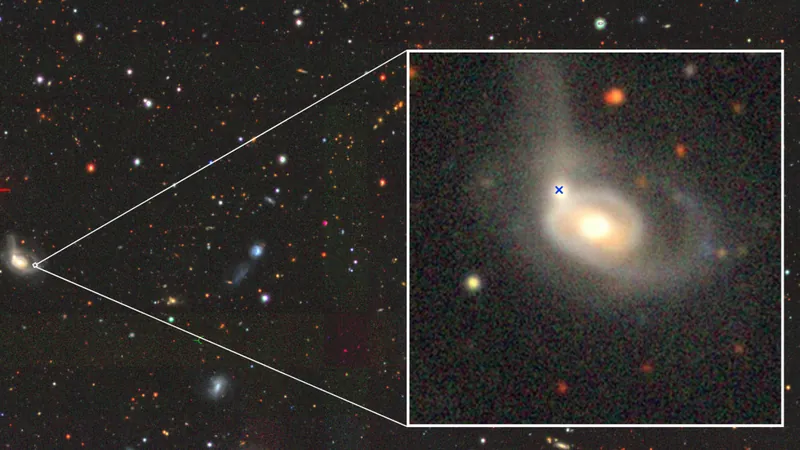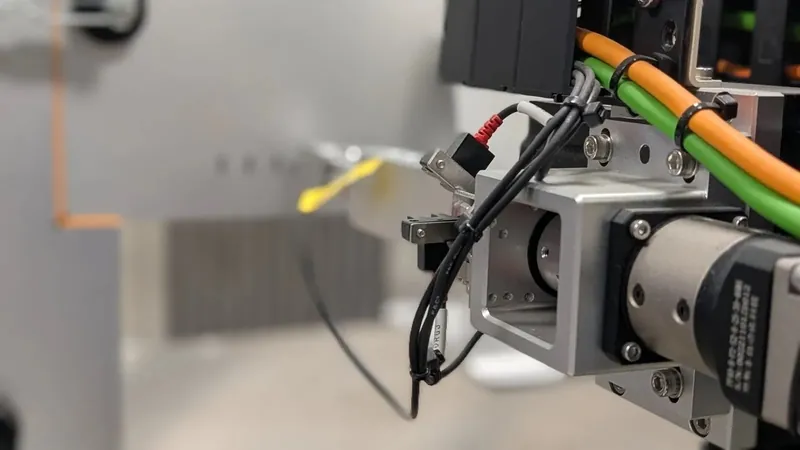
Cosmic Carnage: Astronomers Capture Black Hole Devouring a Star in a Spectacular Galactic Collision!
2025-05-30
Author: Siti
A Stellar Spectacle Unveiled
In an astonishing revelation, astronomers have zeroed in on a rare and cataclysmic event unfolding in the depths of space: a supermassive black hole tearing apart a star that got too close. These dramatic incidents are known as "tidal disruption events" (TDEs), and researchers are eager to unveil their secrets, shedding light on how they shape the evolution of galaxies.
The Brutal Dance of Darkness and Light
When a star encounters a black hole with a mass millions or even billions of times that of our sun, it faces a brutal fate. The gravitational pull of the black hole shreds the star, devouring it in a cosmic feast that sends brilliant flashes of light across the universe—often outshining all the stars in its galaxy!
Meet AT 2022wtn: The Star-Devouring Beast
This particular TDE, dubbed AT 2022wtn, took place in a galaxy roughly 700 million light-years away and is currently in the early stages of merging with a larger galactic neighbor. The galaxy harboring this extraordinary event is called SDSSJ232323.79+104107.7, which is the smaller of the pair involved in this cosmic collision.
A Game-Changer in TDE Discoveries
A mere two detections of TDEs in interacting galaxies have been recorded, defying expectations that these merging conditions would generate more such events. Researchers observed AT 2022wtn through multiple wavelengths—from radio to infrared to X-rays—confirming its incredible nature.
An Unusual Case of Stellar Spaghettification
Led by Francesca Onori from the National Institute for Astrophysics (INAF), the team discovered that the black hole involved weighs about 1 million solar masses and its unfortunate "meal" was a low-mass star. Notably, AT 2022wtn exhibited peculiar characteristics—its light curve displayed a striking plateau of maximum brightness lasting approximately 30 days, before experiencing a temperature drop and showing intriguing emission lines of helium and nitrogen.
The Mechanics of Stellar Destruction
When the doomed star strayed too close to the black hole, immense tidal forces distorted it dramatically, a phenomenon whimsically termed "spaghettification." This process whirled remnants of the star into an accretion disk around the black hole, reminiscent of spaghetti around a fork.
Cosmic Aftermath: Jets and Bright Emissions
Yet, not all stellar debris ended up ensnared by the black hole's grip; significant amounts were ejected as high-speed jets. For AT 2022wtn, these jets emitted a radiant flash in radio wavelengths, marking a tumultuous aftermath of the star's complete annihilation, alongside an expanding cloud of gas.
A Gateway to Galactic Evolution
The spectacular demise of this star not only captivates through its cosmic drama but also promises crucial insights. As astronomers continue to decode these violent galactic narratives, they edge closer to understanding the influences TDEs exert on galaxy formation and evolution, captivating the imagination of both scientists and stargazers alike.




 Brasil (PT)
Brasil (PT)
 Canada (EN)
Canada (EN)
 Chile (ES)
Chile (ES)
 Česko (CS)
Česko (CS)
 대한민국 (KO)
대한민국 (KO)
 España (ES)
España (ES)
 France (FR)
France (FR)
 Hong Kong (EN)
Hong Kong (EN)
 Italia (IT)
Italia (IT)
 日本 (JA)
日本 (JA)
 Magyarország (HU)
Magyarország (HU)
 Norge (NO)
Norge (NO)
 Polska (PL)
Polska (PL)
 Schweiz (DE)
Schweiz (DE)
 Singapore (EN)
Singapore (EN)
 Sverige (SV)
Sverige (SV)
 Suomi (FI)
Suomi (FI)
 Türkiye (TR)
Türkiye (TR)
 الإمارات العربية المتحدة (AR)
الإمارات العربية المتحدة (AR)